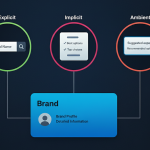Google AI Overviews: How to remove or suppress negative content

By now, we’re all familiar with Google AI Overviews. Many queries you search on Google now surface responses through this quick and prominent search feature.
But AI Overview results aren’t always reliable or accurate.
Google’s algorithms can promote negative or misleading content, making online reputation management (ORM) difficult.
Here’s how to stay on top of AI Overviews and your ORM – by removing, mitigating, or addressing negative content.
How AI Overviews source information
AI Overviews relies on a mix of data sources across Google and the open web, including:
- Google’s Knowledge Graph: The Knowledge Graph is Google’s structured database of facts about people, places, and things. It’s built from a range of licensed data sources and publicly available information.
- Google’s tools and databases: Google also draws on structured data from its own systems. This includes information from:
- Business Profiles.
- The Merchant Center.
- Other Google-managed datasets that commonly appear in search results.
- Websites: AI Overviews frequently cites content from websites across the open web. The links that appear beside answers point to a wide variety of sources, ranging from authoritative publishers to lower-quality sites.
- User-generated content (UGC): UGC can also surface in AI Overviews. This may include posts, reviews, photos, or publicly available content from community-driven platforms like Reddit.
Several other factors influence how this data is organized into answers, including topical relevance, freshness, and the authority of the source.
However, even with relevance and authority taken into consideration, harmful or false content can still appear in results.
This can happen for a variety of reasons, including:
- Where the information is sourced.
- How Google’s AI fills in gaps.
- Instances where it may misunderstand the context of a user’s query.
Removing or suppressing harmful content
There are several options for removing or suppressing negative information on the web, including those related to AI Overviews. Let’s look at two.
Legal and platform-based removal
From time to time, you are left with no other option but to take legal action.
In certain instances, a Digital Millennium Copyright Act (DMCA) claim or defamation lawsuit might be applicable.
A DMCA claim can be initiated at the request of the content owner. A defamation lawsuit, meanwhile, aims to establish libel by showing four things:
- A false statement purporting to be fact.
- Publication or communication of that statement to a third person.
- Fault amounting to at least negligence.
- Damages, or some harm caused to the reputation of the person or entity who is the subject of the statement.
Defamation standards vary by jurisdiction, and public figures may face a higher legal standard.
Because of this, proper documentation and professionalism are essential when filing a lawsuit, and working with a legal professional is likely in your best interest.
Dig deeper: Generative AI and defamation: What the new reputation threats look like
Working with an ORM specialist
The other (and perhaps easier) route to take is working with an online reputation management specialist.
These teams are extremely well-versed at handling the multi-layered process of removals.
In an online crisis, they have the tools to respond and mitigate damage. They’re also trained to balance ethical considerations you might not always account for.
Get the newsletter search marketers rely on.
See terms.
How to deliver positive signals to AI systems
Clearer signals make it easier for AI Overview to present your brand correctly. Focus on the following areas.
Strengthening signals through publishing
One effective method is strategic publishing.
This means building a strong, positive presence around your company, business, or personal brand so AI Overviews have authoritative information to draw from.
A few approaches support this:
- Publishing on credible domains: ORM firms often publish content on platforms like Medium, LinkedIn, and reputable industry sites. This strengthens your presence in trusted environments.
- Employing consistent branding and factual accuracy: Content must also be factual and consistently branded. This reinforces authority and signals reliability.
- Leveraging press releases and thought leadership: Press releases, thought leadership pieces, and expert commentary help create credible backlinks and citations across the web.
- Supporting pages that build the narrative: ORM specialists also create supporting pages that reinforce key narratives. With the right linking and content clusters, AI Overviews is more likely to surface this material.
Leveraging structured data and E-E-A-T
Another effective method to establish credibility on AI Overviews is to focus on technical enhancements and experience, expertise, authoritativeness, and trustworthiness (E-E-A-T).
ORM specialists typically focus on two areas:
- Structured data and schema markup: This involves adding more context about your brand online by:
- Enhancing author bios.
- Highlighting positive reviews.
- Reinforcing signals that reflect credibility.
- Establishing E-E-A-T signals: This includes building a trusted online presence by:
- Referencing work published in reputable outlets.
- Highlighting real client examples.
- Showcasing customer relationships.
- Outlining accolades and expertise through your bio.
Monitoring AI Overviews and detecting issues early
A final key aspect of staying on top of AI Overviews is to monitor the algorithm and detect issues early.
Using tools to track AI Overviews is extremely efficient, and these systems can help business owners monitor keywords and detect potential damage.
For instance, you might use these tools to track your brand name, executive names, or even relevant products.
As discussed, it’s also crucial to have a plan in place in case a crisis ever hits.
This means establishing press outreach contact points and a legal department, and knowing how to suppress content via the suppression methods already mentioned.
Ethical considerations
Online reputation management isn’t just generating think pieces. It’s a layered process grounded in ethical integrity and factual accuracy.
To maintain a truthful and durable strategy, keep the following in mind:
- Facts matter: Don’t aim to manipulate or deceive. Focus on promoting factual, positive content to AI Overview.
- Avoid aggression: Aggressive tactics rarely work in ORM. There’s a balance between over-optimization and under-optimization, and an ORM firm can help you find it.
- Think long-term: You may want negative or false content removed immediately, but lasting suppression requires a long-term plan to promote positive content year after year.
Managing how AI Overviews presents your brand
AI Overviews is already a dominant part of the search experience.
But its design means negative or false content can still rise to the top.
As AI Overviews become more prominent, business owners need to monitor their online reputation and strengthen the positive signals that surface in these results.
Over time, that requires strategic publishing, long-term planning, the right technical signals, and a commitment to factual, honest content.
By following these principles, AI Overviews can become an asset for growth instead of a source of harm.










Recent Comments